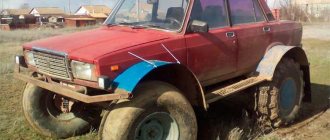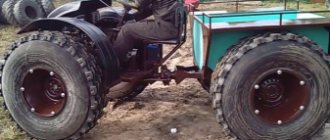Homemade 4x4 all-terrain vehicle, equipped with a motorcycle or car? engine or a motor from agricultural machinery, is able to overcome deep snow and swampy areas of the forest. The articulated connection of the frame sections provides increased maneuverability and maneuverability on soft soils. The design uses parts from cars, which further reduces the cost of building an all-terrain vehicle.
Design Features
Fracture all-terrain vehicles are equipped with steel frame bases connected by a hinge (for example, a steering knuckle from UAZ vehicles). The axles are rigidly attached to the frames, but there are versions with leaf spring suspension. The turning point allows the swamp vehicle to maneuver while moving; Classic steering with tilt wheels is rarely used in DIY technology. The engine with a mechanical transmission is connected by a driveshaft to a transfer gearbox, which distributes the power flow between the drive axles.
Fracture swamp vehicles with Lifan engine
After determining the layout of the all-terrain vehicle, you can begin turning work. To do this, follow the following instructions step by step.
You need to prepare a four-stroke variator from a scooter. Its convenience lies in the easy regulation of clutch speed and operation. Such gearboxes are installed on engines with power up to 14 hp.
Then it’s worth tackling the caracat’s rear axle and cones. Then you can move on to making flanges for the wheels.
It is advisable to make the seat using standard technology. Coat the mold with wax and place fiberglass on it. It must be impregnated with resin several times. The hardened seat should be removed from the mold, bolted to the ATV frame, and painted to improve appearance.
The gearbox must be taken from a Honda. Although you can use the transmission from Oka. The gearbox must be installed on the caracat frame.
Common models
Among homemade structures, the most common are all-terrain vehicles made of 2 sections; Three-segment machines are rarely created because, due to their increased length, they have low maneuverability. The units are equipped with 2 permanent drive axles. There are modifications with an additional drive axle. In this case, a leaf spring from GAZelle trucks is introduced into the suspension circuit, which is mounted on a balancer.
The most common designs:
- Design with a Lifan engine, which is connected to a gearbox from classic VAZ cars by a belt drive. To control the machine, a worm gearbox or a rack from front-wheel drive Lada cars can be used, which is connected by a rod to a lever securely mounted on the steering knuckle. In front there is a hard seat for the driver; it is possible to install a seat from a car with foam padding. The rear compartment is used to transport cargo or people; Some vehicles are provided with a tarpaulin cover.
- Scheme with a liquid-cooled power unit with 2 or 4 cylinders, borrowed from VAZ cars or foreign-made equipment. The advantage of all-terrain vehicles is an increased power reserve and a pedal-driven clutch. The vacuum brake booster is retained; Hydraulics are used to drive the mechanisms. The cars are heavier; To maintain low ground pressure, tires with an increased tread width are used.
- A rare modification of a 6x6 all-terrain vehicle with a balanced suspension for 2 rear axles, which allows you to install a cargo compartment with increased capacity. The transmission design may use driveshafts or ball joints from front-wheel drive vehicles.
Some conclusions
As a kind of conclusion, the following can be said about breakaway all-terrain vehicles:
- The technique is popular. Those who know how to work with their hands make their own versions. Those who do not know how to work with their hands order special equipment from craftsmen;
- You can create such an all-terrain vehicle from any spare parts at hand. As a last resort, you can inexpensively buy several cars from the USSR era: VAZ-2106, UAZ and Moskvich, and assemble them into good pieces;
- An all-terrain vehicle can become a truly reliable assistant in overcoming off-road conditions.
How to make a fracture with your own hands
A 4x4 all-terrain vehicle of the utilitarian type can be manufactured independently. Assembly will require drawings (developed from scratch or using documentation from magazines), as well as a place for installation work.
It is necessary to prepare a set of metalworking tools, a welding machine, measuring devices and a drilling machine (it is possible to use an electric drill).
During the assembly process, the design will need to be refined, since the drawing documentation cannot take into account all the design features of the parts and assemblies used.
Required materials and parts
Minimum set of components for assembly:
- power unit with attachments and exhaust system;
- drive axles with installed differentials and identical main pairs;
- gearbox and transfer gearbox;
- cardan shafts;
- cooling system radiator;
- steering knuckle for connecting sections;
- steel profile of closed section;
- tires (of the “flap” type);
- additional materials for the manufacture of steering and body elements.
Frame making
For the manufacture of space frame sections, pieces of steel profiles are used, held together by resistance welding. During manufacturing, the dimensions of the engine and transmission units are taken into account, and the installation of attachment points for the units is provided. The frame design must withstand the weight of the installed equipment and additional loads that arise when moving through a swamp or deep snow. If cracks and breaks appear during operation, the load-bearing frame will need to be reworked.
The frame is provided with end plates with holes for attaching the movable fist. There is a hole inside the knuckle through which the driveshaft is passed. This solution reduces the risk of damage to the drive when driving over rough terrain. The semi-frames have points for installing bridges, equipped with reinforcements. To determine the correctness of the construction, a trial installation of the units is carried out. It is recommended to clean the frame from traces of corrosion and cover it with a layer of acidic primer to prevent corrosion.
Installation of box and bridges
The box is attached to the power unit or installed separately (for example, in designs with a Lifan engine from agricultural machinery). The gearbox and transfer case are installed on cushions with rubber inserts that reduce the level of vibrations. The bridges are placed on brackets and then secured with stepladders and nuts. It is not recommended to weld the parts, since the bridge stockings warp, which causes bending and damage to the axle shafts. The cardan shafts must be trimmed, and then the pipe must be connected to the hinges by resistance welding.
Painting
For painting, a special paint for metal structures is used, which has increased resistance to impacts. The enamel is applied with a spray gun; Points and parts that cannot be painted are first covered with tape. External body panels can be painted with automotive paint; some owners use sheets of corrugated aluminum that do not rot under the influence of natural precipitation.
Installation of the power unit
The power unit is installed in the front of the all-terrain vehicle; When using liquid cooling, space is provided for mounting a radiator. The direction of the antifreeze supply and intake pipes, which must be connected with rubber hoses, should be taken into account. The motor is mounted on standard points on cushions with elastic elements that reduce vibrations and prevent the motor from moving to the sides. Since homemade structures use an electrical circuit, a relay and fuse box is installed.
A fuel tank is mounted on the frame, which is connected by lines to a mechanical pump. If you plan to use a motor with distributed gasoline injection, then consider a place to install the control controller. The Check Engine indicator is displayed on the instrument panel, allowing timely detection of malfunctions in the power unit systems. Regardless of the type of fuel supplied to the engine, a coolant temperature gauge or indicator is provided.
Wheel installation
To install 4 larger wheels, modified wheels from VAZ passenger cars are used. Standard - allow you to mount tires on factory hubs without using new bolts or studs. An additional rim is welded on top of the disk; the symmetry of the structure is ensured by installing a steel profile of a suitable size into the gap. The structure is tacked by welding and then checked for absence of runout. If the disk is assembled correctly, then it is necessary to carry out final welding of the parts.
The homemade all-terrain vehicle is equipped with wheels on low-pressure tires, which are additionally stripped with an abrasive tool. The steel cord is pre-removed from the tire structure, which reduces weight and increases the elasticity of the tire. There is a tube inside the tire; the tube with the nipple is brought out onto the side of the disk and then covered with a removable steel shield. After assembly is completed, the snow and swamp-going vehicle is checked on rough terrain - if any breakdowns are detected, the design is repaired and modified.
Major failures of all-terrain vehicles
The main malfunctions of home-made structures are associated with the low residual life of the components used. For example, due to increased loads in the transmission (due to the lack of a center differential), the gears of the main pairs and the transfer gearbox are destroyed. The all-terrain vehicle's fracture unit generally does not experience loads exceeding the design values, so there are no problems with the hinge. When driving off-road, the keys on the cardan shafts and the outboard bearing (used on some modifications of Karakat all-terrain vehicles) may be damaged.











